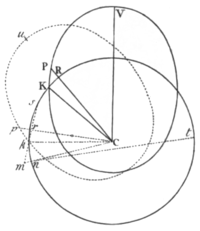to the velocity of the deſcribing line CP; that is, as the angle VCp to the angle VCP, therefore in a given ratio, and therefore proportional to the time. Since then the area deſcribed by the line Cp in an immovable plane is proportional to the time, it is manifeſt that a body, being acted upon by a juſt quantity of centripetal force, may revolve with the point p in the curve line which the ſame point p, by the method juſt now explained, may be made to deſcribe in an immovable plane. Make the angle VCu equal to the angle PCp, and the line Cu equal to CV and the figure uCp equal to the figure VCP, and the body being always in the point p, will move in the perimeter of the revolving figure uCp, and will deſcribe its (revolving) arc up in the ſame time that the other body P deſcribes the ſimilar and equal arc VP in the quieſcent figure VPK. Find then by cor. 5. prop. 6. the centripetal force by which a body may be made to revolve in the curve line which the point p deſcribes in an immovable plane, and the problem will be ſolved. Q. E. F.
Proposition XLIV. Theroem XIV.
The difference of the forces, by which two bodies may be made to move equally, one in a quieſcent, the other in the ſame orbit revolving, is in a triplicate ratio of their common altitudes inverſely.

Let the parts of the quieſcent orbit VP, PK, (Pl. 18. Fig. 2.) be ſimilar and equal to the
